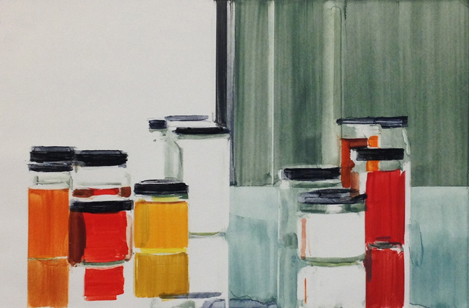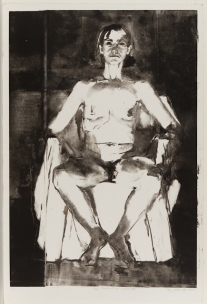Walk into Peri Schwartz’s studio outside New York City, and you might see angular stacks of books on a table, light pouring in from a large window, canvases leaning against the wall, and translucent glass bottles and jars filled with richly colored liquids. Instead of inventing subjects, Schwartz prefers to work directly from life, and the objects that occupy her studio space also serve as subjects for her paintings, drawings, and prints.

I recently had the opportunity to speak with Ms. Schwartz, and learn more about her artistic process and inspirations. One of Schwartz’s artworks in the Mead’s permanent collection, Bottles & Jars XXXI (2009, monotype), is part of a larger series of monotype prints. Monotype is a specific printmaking process that involves painting ink directly onto a glass surface or panel and using a press to transfer the ink to paper. Schwartz says that she first started making prints while at the Boston University School of Fine Arts, and has continued developing this process ever since. She works in painting and drawing in addition to printmaking, often focusing for long periods on a single medium. For example, she says that she just spent six months working on monotypes and has now switched back to painting. She says that every time she returns to painting, drawing, or printing she feels like she is rediscovering the medium. Each one, she says, requires a different way of thinking.

In her work, Schwartz says she strives for a balance between representation and abstraction. One of the ways she achieves this is through a grid technique, which she acquired in school when learning the basics of composition, and which is now an essential part of her work. She initially applied the grid when composing self-portraits, such as Self-Portrait at Night IV (1985, monotype), as a way to remember exactly where she was sitting, and now uses grids in all of her work. Schwartz’s grids extend beyond the canvas or paper and onto the walls, tables, and books in her studio, turning the space into a real-life grid with intervals on the walls and in the painting.

One of the reasons Schwartz says she loves working with monotypes is that they function as a record of where she’s been compositionally. Prints are much more immediate than painting or drawing, and each monotype typically yields two prints — the original print and what is often called a ghost print, which is made with the ink left on the plate after the first printing. These ghost prints can be great ways to build new colors and interpret the composition in a new way. More prints can be laid on top of the ghost print, similar to a color etching where a different etched plate is used for each color. Schwartz’s video on monotyping provides a good overview of the process: https://vimeo.com/121209304.
Schwartz uses plexiglass as the surface for the prints, and Q-tips to clean up the lines of the forms and colors. One of the things she likes about printmaking, she says, is the freshness of colors that can be achieved, and that the original white of the paper can be maintained to bring out these colors. In printmaking Schwartz says that she feels there is more space between the composition and the actual paper, leaving room for necessary contemplation of the arrangement of the subject before putting ink to the plexiglass plate. Prints cannot be erased or painted over, and the final work is the product of only a few prints of a certain plate.
The series to which Bottles & Jars XXXI belongs focuses exclusively on bottles and jars. Schwartz sees this series as a “marriage of subject matter” and medium, combining the liquid of ink with the liquid in the bottles. In Bottles & Jars XXXI, an intense red liquid overlaps a jar with orange liquid, and white bottles are set in contrast next to yellow and red. The colors reflected on the table and the overlapping cylindrical forms make this print both realistic and abstract.

Schwartz’s monotype Bottles & Jars XXXI, as well as her self-portrait monotype and recent painting, all exemplify her combination of realism and abstraction. By working directly from life, using the grid to lay out and analyze each composition, and continuously rearranging the composition, Schwartz’s work has an undeniable sense of energy and coherence that still lifes often lack.
Written by Catherine Rose O’Brien, Class of 2017